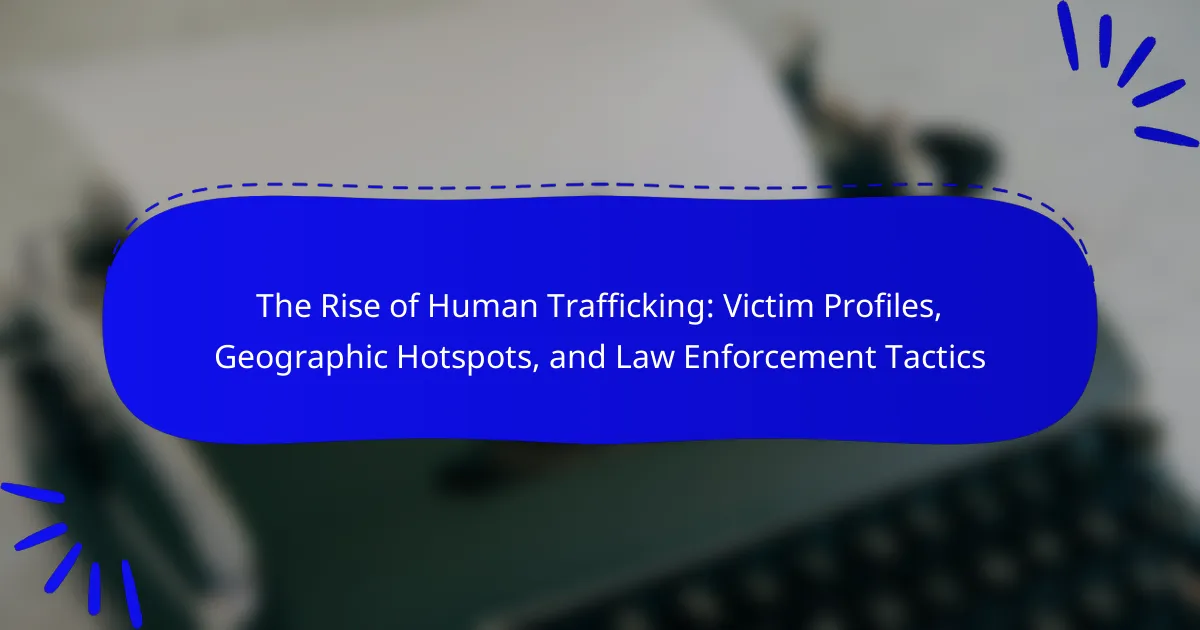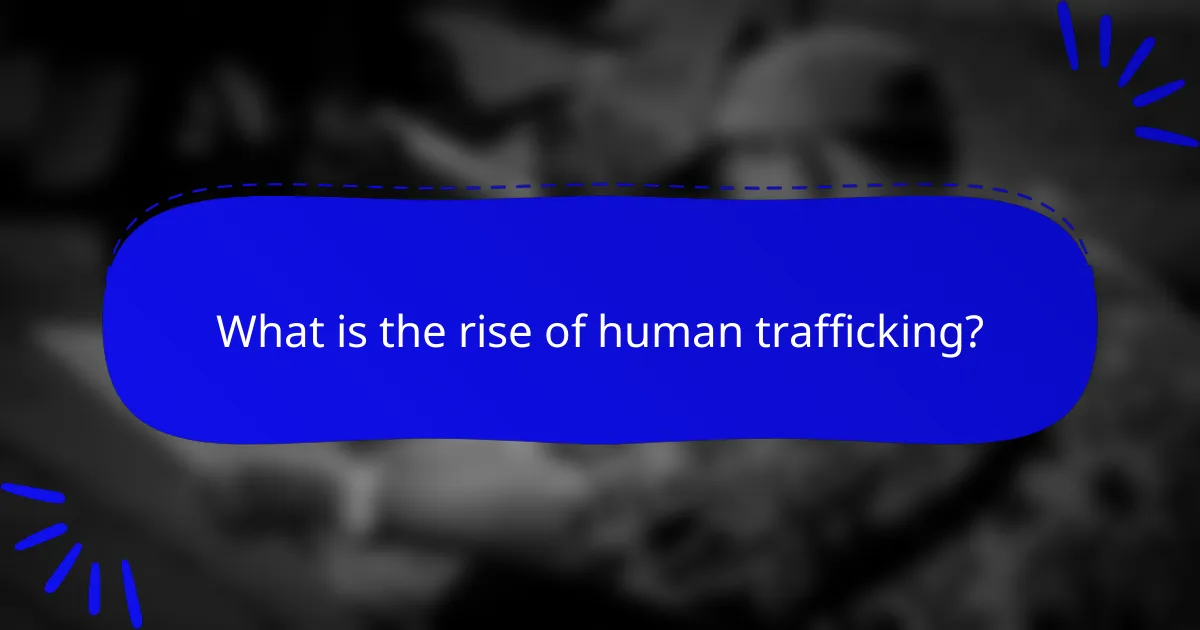
What is the rise of human trafficking?
The rise of human trafficking refers to the increasing prevalence of the illegal trade of humans for exploitation. This phenomenon has escalated globally over the past two decades. According to the United Nations Office on Drugs and Crime, an estimated 2.5 million people are victims of trafficking at any given time. Factors contributing to this rise include poverty, conflict, and lack of education. In regions with economic instability, individuals are more vulnerable to traffickers. Additionally, advancements in technology have facilitated the recruitment and exploitation of victims. The trafficking of individuals for labor and [censured] exploitation has become a significant issue worldwide. Countries with high demand for cheap labor and [censured] services often serve as hotspots for trafficking activities. Law enforcement agencies struggle to combat this issue due to limited resources and the clandestine nature of trafficking networks.
How has human trafficking evolved over time?
Human trafficking has evolved significantly over time, transitioning from historical forms of slavery to modern exploitation. In ancient civilizations, such as Greece and Rome, human trafficking primarily involved the capture and sale of slaves. The transatlantic slave trade in the 16th to 19th centuries marked a major escalation, forcibly transporting millions of Africans to the Americas for labor.
In recent decades, the nature of human trafficking has shifted. Today, it encompasses various forms, including [censured] trafficking and labor exploitation. Globalization and technological advancements have facilitated these modern practices. According to the International Labour Organization, an estimated 40.3 million people are victims of human trafficking worldwide as of 2016.
Furthermore, the rise of the internet has enabled traffickers to exploit vulnerable individuals more effectively. Social media and online platforms are often used to recruit and advertise victims. Legislative changes and international agreements, such as the Palermo Protocol in 2000, have aimed to combat trafficking, yet challenges persist.
The evolution of human trafficking reflects changing economic, social, and technological landscapes. Increased awareness and advocacy have emerged, but the complexity of the issue continues to pose significant obstacles.
What historical factors have contributed to the rise of human trafficking?
The rise of human trafficking has been influenced by several historical factors. Colonialism and the transatlantic slave trade established patterns of exploitation. Economic instability and poverty in many regions have made individuals vulnerable to trafficking. Wars and conflicts have displaced populations, leading to increased trafficking risks. Additionally, globalization has facilitated the movement of people and goods, complicating enforcement efforts. Legal gaps and inadequate protections have allowed traffickers to operate with impunity. Historical discrimination and social inequalities have also played a role in victimization. These factors collectively contribute to the ongoing challenge of human trafficking today.
How do societal changes influence human trafficking trends?
Societal changes significantly influence human trafficking trends by altering demand and vulnerability factors. Economic instability often leads to increased trafficking as individuals seek better opportunities. Changes in migration patterns can create vulnerable populations, susceptible to exploitation. Social attitudes towards marginalized groups can either mitigate or exacerbate trafficking risks. Increased awareness and advocacy can lead to stronger legal frameworks, impacting trafficking rates. For instance, the 2018 Global Report on Trafficking in Persons by the United Nations Office on Drugs and Crime highlights how economic downturns correlate with spikes in trafficking cases. Furthermore, shifts in technology, such as social media, can facilitate recruitment for trafficking. Overall, societal dynamics play a crucial role in shaping the landscape of human trafficking.
What are the primary causes of human trafficking?
The primary causes of human trafficking include poverty, lack of education, and political instability. Poverty creates vulnerability, leading individuals to seek better opportunities. Lack of education limits awareness of rights and available resources. Political instability can result in displacement, making people easier targets for traffickers. Additionally, demand for cheap labor and [censured] exploitation drives trafficking networks. According to the International Labour Organization, there are approximately 40.3 million victims of human trafficking globally. These factors contribute to a complex environment that allows trafficking to thrive.
How do economic factors drive human trafficking?
Economic factors drive human trafficking primarily through poverty and lack of opportunities. Individuals in impoverished regions often seek better livelihoods. Traffickers exploit this vulnerability by offering false promises of employment. Economic instability increases desperation, making people more susceptible to coercion. According to the International Labour Organization, around 40.3 million people are victims of modern slavery, with economic hardship being a significant contributing factor. Additionally, regions with high unemployment rates see a rise in trafficking incidents. The demand for cheap labor in various industries further fuels this crisis. Economic disparities create environments where trafficking can thrive.
What role does demand for cheap labor and services play in human trafficking?
Demand for cheap labor and services significantly fuels human trafficking. This demand creates a lucrative market for traffickers. Businesses often seek low-cost labor to maximize profits. Vulnerable populations become targets for exploitation in this context. Traffickers exploit economic desperation to recruit victims. Many victims are coerced into labor under threats or deception. According to the International Labour Organization, 24.9 million people are trapped in forced labor globally. This statistic highlights the scale of the issue linked to cheap labor demands.
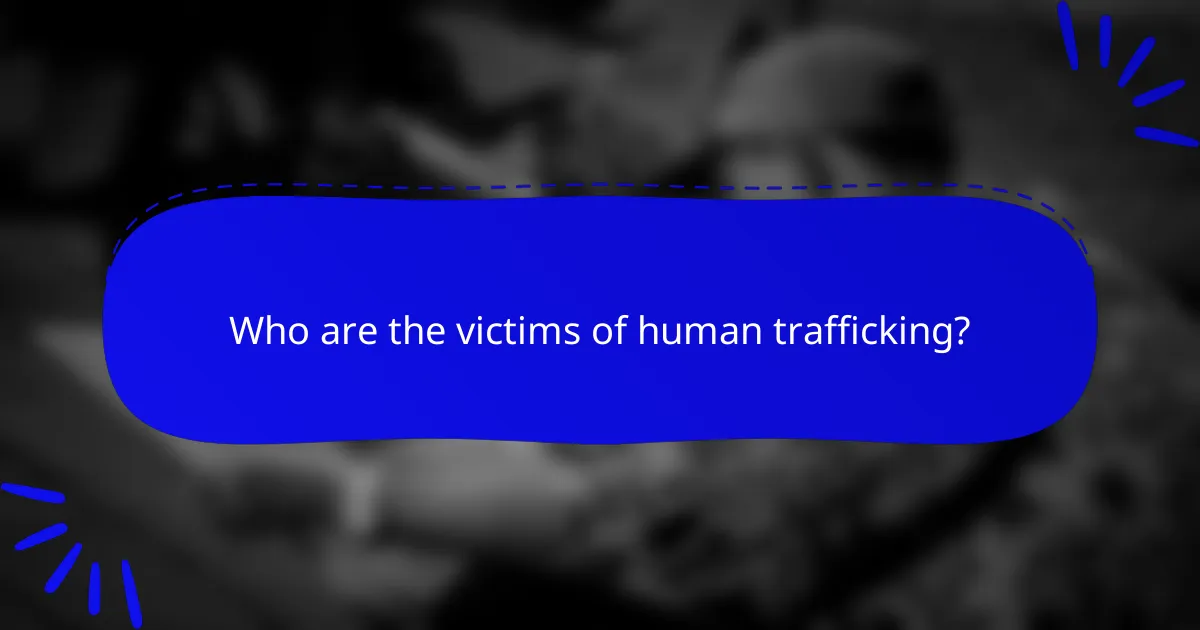
Who are the victims of human trafficking?
Victims of human trafficking include individuals of all ages, genders, and backgrounds. They are often coerced, deceived, or forced into exploitative situations. Women and children are particularly vulnerable, making up a significant portion of trafficking cases. According to the United Nations, approximately 71% of human trafficking victims are women and girls. Many victims are trafficked for [censured] exploitation, while others are forced into labor. Economic instability and lack of education increase susceptibility to trafficking. Additionally, marginalized communities face higher risks. The International Labour Organization estimates that 40.3 million people are victims of modern slavery globally.
What are the common profiles of human trafficking victims?
Common profiles of human trafficking victims include women, children, and marginalized populations. Women often represent a significant portion of victims, particularly in [censured] exploitation cases. Children are frequently trafficked for labor or [censured] purposes. Marginalized populations, including refugees and those in poverty, are at higher risk. Victims often come from areas with limited economic opportunities. Studies indicate that 71% of trafficking victims are women and girls, according to the United Nations Office on Drugs and Crime (UNODC). Furthermore, children make up about 30% of detected trafficking victims globally.
How do age and gender affect vulnerability to human trafficking?
Age and gender significantly influence vulnerability to human trafficking. Younger individuals, particularly children and adolescents, are often targeted due to their perceived innocence and limited ability to defend themselves. According to the United Nations Office on Drugs and Crime, approximately 30% of trafficking victims globally are children.
Gender also plays a critical role. Women and girls make up a large majority of trafficking victims, particularly in [censured] exploitation. The same UNODC report indicates that 79% of all trafficking victims detected globally are women and girls.
This data highlights how age and gender intersect to create heightened risks for specific groups. Vulnerable populations often lack resources and support systems, making them easier targets for traffickers.
What socio-economic factors increase the risk of becoming a victim?
Poverty increases the risk of becoming a victim of human trafficking. Individuals in low-income areas often lack access to education and job opportunities. This economic instability makes them vulnerable to exploitation. Additionally, lack of social support systems can leave individuals isolated. High unemployment rates contribute to desperation, leading people to seek risky employment. Marginalized communities face discrimination, increasing their susceptibility to trafficking. Furthermore, unstable family environments can push individuals into dangerous situations. According to the International Labour Organization, 40.3 million people are victims of modern slavery, with socio-economic factors playing a critical role in their vulnerability.
What psychological effects do victims experience?
Victims of human trafficking experience severe psychological effects. Common effects include post-traumatic stress disorder (PTSD), depression, and anxiety. Many victims struggle with feelings of shame and guilt. They often face difficulties in trusting others due to their trauma. Emotional numbness and detachment are also prevalent among survivors. Research indicates that 70% of trafficking survivors report symptoms of PTSD. These psychological issues can persist long after the trafficking experience ends. Access to mental health support is crucial for recovery.
How does trauma impact the lives of human trafficking survivors?
Trauma significantly impacts the lives of human trafficking survivors. Survivors often experience long-term psychological effects, such as PTSD, anxiety, and depression. These mental health issues can hinder their ability to reintegrate into society. Survivors may struggle with trust and relationship-building due to their traumatic experiences. Many face stigma and discrimination, further isolating them. Physical health problems are also common, resulting from abuse and neglect during their trafficking. According to the National Trafficking Survivor Study, 87% of survivors reported experiencing trauma-related symptoms. Access to support services is crucial for recovery, yet many survivors encounter barriers to these resources.
What support systems are available for victims of human trafficking?
Support systems for victims of human trafficking include shelters, counseling services, and legal assistance. Shelters provide safe housing and basic needs for victims. Counseling services offer psychological support to aid recovery. Legal assistance helps victims navigate the justice system and secure their rights. Many non-profit organizations, such as Polaris and the Salvation Army, provide these resources. Additionally, government programs may offer financial aid and rehabilitation services. These support systems aim to empower victims and facilitate their reintegration into society.
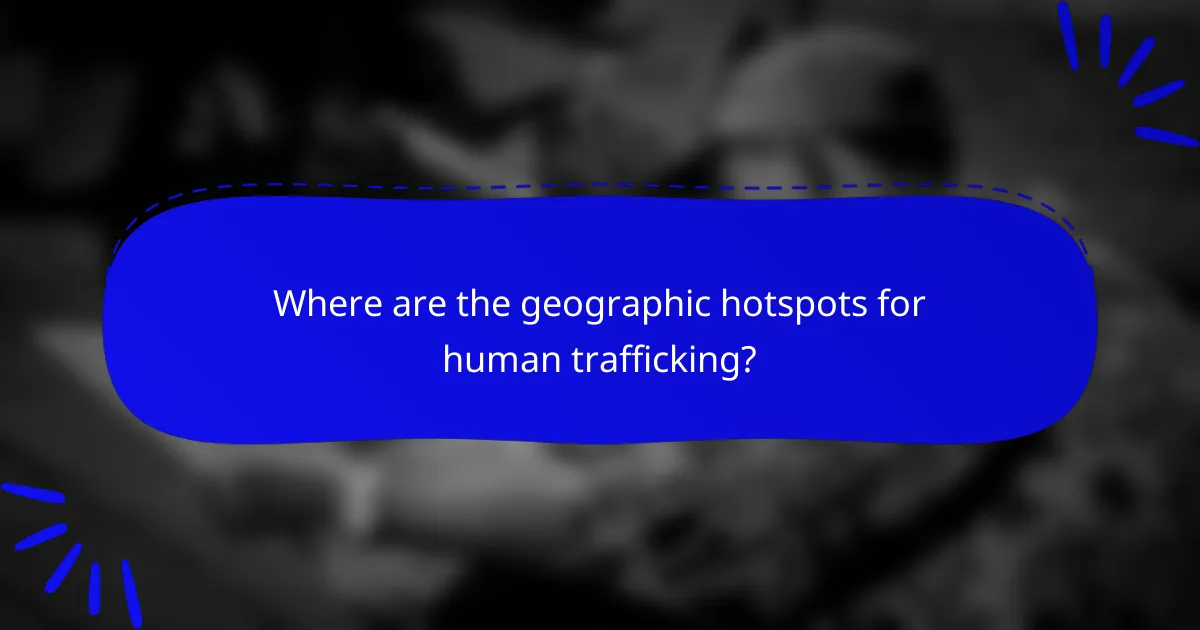
Where are the geographic hotspots for human trafficking?
Geographic hotspots for human trafficking include regions with high vulnerability and demand for cheap labor or [censured] exploitation. Major hotspots are found in Southeast Asia, particularly Thailand and Cambodia. Other significant areas include Eastern Europe, especially Moldova and Ukraine. The United States also reports high trafficking rates in urban centers like Los Angeles and New York City. According to the Global Slavery Index, an estimated 40.3 million people are victims of modern slavery, with concentrated cases in these regions. Factors contributing to these hotspots include poverty, conflict, and lack of law enforcement.
What regions are most affected by human trafficking?
Asia, Africa, and Europe are the regions most affected by human trafficking. According to the United Nations Office on Drugs and Crime (UNODC), Asia is a significant hotspot due to high population density and economic disparities. Africa faces challenges such as poverty and conflict, which contribute to trafficking. Europe is impacted by both internal and external trafficking networks. The Global Slavery Index indicates that millions are affected worldwide, with these regions showing the highest prevalence rates. In 2021, the European Commission reported a rise in human trafficking cases, particularly for [censured] exploitation and forced labor.
How do migration patterns contribute to geographic hotspots?
Migration patterns significantly contribute to the emergence of geographic hotspots for human trafficking. Increased movement of people often leads to a rise in vulnerability among migrants. Areas with high migration rates tend to have inadequate resources and support systems. This creates opportunities for traffickers to exploit individuals. For instance, urban centers that attract migrants may experience a surge in demand for cheap labor and services. Consequently, traffickers target these locations to recruit victims. Data shows that regions with high migrant populations see a correlation with increased trafficking incidents. The International Organization for Migration reported that migrants are often unaware of their rights and available protections, making them prime targets. Thus, migration patterns directly influence the prevalence of human trafficking in specific geographic areas.
What role do conflict and instability play in human trafficking hotspots?
Conflict and instability significantly contribute to the prevalence of human trafficking hotspots. In regions experiencing war or political turmoil, law enforcement and social services often weaken. This lack of oversight creates environments where traffickers can operate with impunity. Vulnerable populations, including refugees and displaced individuals, become prime targets for exploitation. According to the United Nations Office on Drugs and Crime, conflict zones account for a high percentage of trafficking victims. Additionally, economic instability exacerbates poverty, driving individuals to seek desperate means for survival. This desperation increases susceptibility to traffickers’ false promises of safety and employment. Thus, conflict and instability create a perfect storm for human trafficking to flourish.
What are the trends in human trafficking across different countries?
Human trafficking trends vary significantly across different countries. In many regions, there is an increase in trafficking for labor exploitation. Countries in Southeast Asia report high instances of individuals trafficked for agricultural and construction work. Eastern Europe sees a rise in [censured] trafficking, often linked to organized crime.
North America has noted a growing trend in domestic trafficking, particularly involving minors. The International Organization for Migration reported that in 2021, 25% of detected victims were children.
Additionally, conflict zones experience higher trafficking rates due to instability. The Global Slavery Index indicates that countries like India and China have the highest number of trafficking victims globally.
Law enforcement efforts are evolving to tackle these trends, with many nations enhancing cooperation across borders.
How do laws and enforcement vary by country in addressing human trafficking?
Laws and enforcement addressing human trafficking vary significantly by country. Some nations have comprehensive legal frameworks and strict penalties for traffickers. Countries like the United States and Canada have established robust anti-trafficking laws. They also provide victim support services and training for law enforcement.
Conversely, other countries may lack specific laws against human trafficking. In these nations, enforcement is often weak or non-existent. Factors such as corruption and limited resources hinder effective law enforcement.
International treaties, like the Palermo Protocol, aim to standardize laws globally. However, compliance and implementation differ widely. According to the U.S. State Department’s Trafficking in Persons Report, many countries still struggle with enforcement challenges.
Cultural attitudes towards trafficking also influence legal frameworks. In some regions, societal norms may discourage reporting or addressing trafficking. This leads to underreporting and inadequate responses. Overall, the effectiveness of laws and enforcement against human trafficking is inconsistent worldwide.
What international efforts are being made to combat human trafficking?
International efforts to combat human trafficking include treaties, awareness campaigns, and law enforcement collaboration. The United Nations has established the Protocol to Prevent, Suppress and Punish Trafficking in Persons, especially Women and Children. This protocol aims to create a comprehensive framework for countries to address trafficking. Additionally, organizations like INTERPOL facilitate international police cooperation. They support information sharing and joint operations. The Global Action to Prevent and Address Trafficking in Persons and the Smuggling of Migrants is another initiative. It provides technical assistance to countries for implementing anti-trafficking measures. The U.S. Department of State also publishes the Trafficking in Persons Report annually. This report evaluates countries’ efforts to combat trafficking and promotes accountability. These combined efforts reflect a global commitment to eradicate human trafficking.
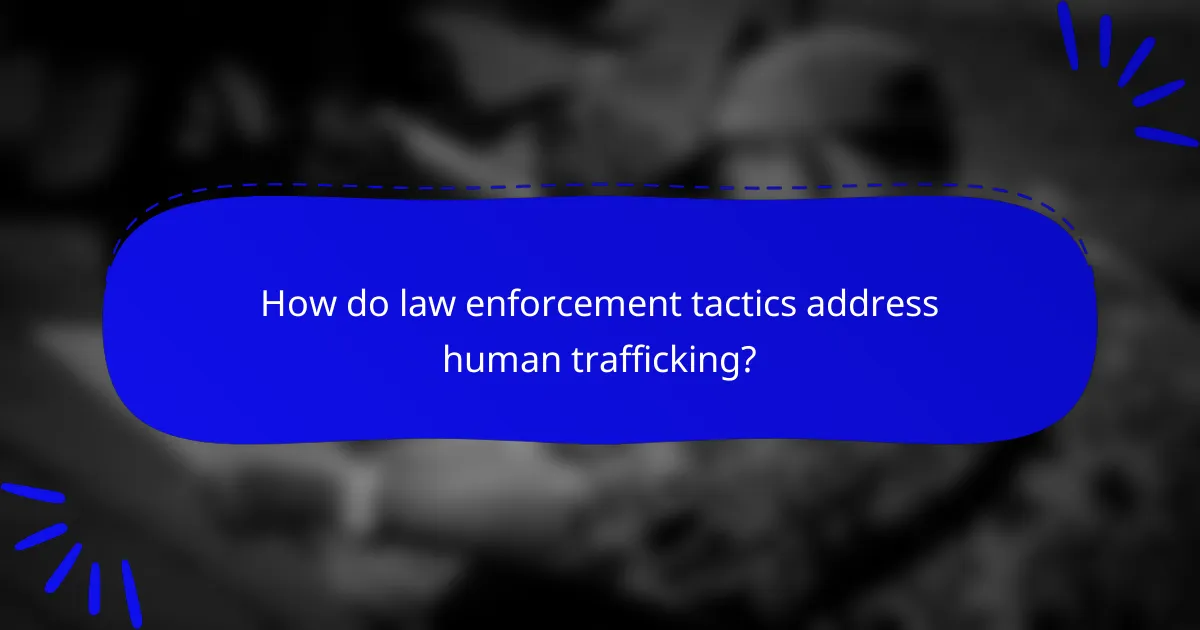
How do law enforcement tactics address human trafficking?
Law enforcement tactics address human trafficking through various strategies aimed at prevention, investigation, and victim support. These tactics include specialized training for officers to recognize signs of trafficking. They also involve collaboration with non-governmental organizations for victim assistance. Law enforcement agencies utilize intelligence sharing to track trafficking networks. They conduct undercover operations to apprehend traffickers. Additionally, community outreach programs raise awareness about trafficking. According to the National Human Trafficking Hotline, law enforcement made 3,200 trafficking-related arrests in 2020. These efforts aim to dismantle trafficking operations and support victims effectively.
What strategies are effective in preventing human trafficking?
Effective strategies in preventing human trafficking include education, awareness campaigns, and law enforcement collaboration. Education programs inform communities about the signs of trafficking and how to report it. Awareness campaigns increase public knowledge and encourage vigilance. Collaborative efforts among law enforcement agencies enhance information sharing and resource allocation. Training for law enforcement improves identification and intervention in trafficking cases. Community involvement fosters a supportive environment for potential victims. Legislation that strengthens penalties for traffickers acts as a deterrent. Research indicates that comprehensive approaches combining these strategies yield the best outcomes in reducing trafficking incidents.
How can community awareness programs help combat human trafficking?
Community awareness programs can significantly help combat human trafficking by educating the public about its signs and prevention. These programs raise awareness about the tactics used by traffickers. They inform communities on how to identify potential victims. Increased knowledge leads to more vigilant communities.
For example, in 2020, the National Human Trafficking Hotline reported over 11,000 cases due to increased awareness. Programs often include training for law enforcement and community members. They empower individuals to report suspicious activities. This proactive approach can disrupt trafficking networks and save lives.
What role does technology play in tracking and preventing human trafficking?
Technology plays a crucial role in tracking and preventing human trafficking. It enables law enforcement agencies to gather and analyze data efficiently. Advanced algorithms can identify patterns in trafficking activities. Geographic information systems (GIS) help map hotspots for trafficking incidents. Mobile applications allow victims to report incidents discreetly. Social media monitoring aids in detecting recruitment tactics used by traffickers. Artificial intelligence enhances the ability to analyze large datasets for potential trafficking cases. According to the International Organization for Migration, technology has improved the identification of victims by 30% in recent years. These technological advancements are vital in combating human trafficking effectively.
How do law enforcement agencies collaborate to tackle human trafficking?
Law enforcement agencies collaborate to tackle human trafficking through coordinated efforts and intelligence sharing. They often form task forces that include multiple jurisdictions. These task forces enhance communication and resource allocation. Agencies utilize technology for data collection and analysis. They also conduct joint training programs to improve skills and knowledge. Information is shared through national databases and communication networks. International collaboration occurs through treaties and agreements. This multi-agency approach increases the effectiveness of investigations and victim assistance.
What are the challenges faced by law enforcement in tackling human trafficking?
Law enforcement faces numerous challenges in tackling human trafficking. One major challenge is the lack of resources, including funding and personnel. Many law enforcement agencies are underfunded and lack specialized training in identifying and handling trafficking cases. Additionally, the clandestine nature of human trafficking makes it difficult to detect and investigate. Victims often do not come forward due to fear of their traffickers or mistrust of authorities.
Another challenge is the complexity of trafficking networks, which often span multiple jurisdictions and countries. This requires extensive cooperation and coordination among various law enforcement agencies. Legal obstacles also hinder efforts, as laws regarding trafficking can vary significantly between regions. Furthermore, cultural and language barriers can complicate communication with victims and witnesses.
According to the International Organization for Migration, over 25 million people are victims of human trafficking globally, highlighting the scale of the problem. These factors collectively impede law enforcement’s effectiveness in combating human trafficking.
How can cross-border cooperation enhance the fight against human trafficking?
Cross-border cooperation can significantly enhance the fight against human trafficking. It allows countries to share intelligence and resources effectively. Collaborative efforts can lead to the identification and apprehension of traffickers operating across borders. Joint task forces can conduct operations that disrupt trafficking networks. Legal frameworks can be harmonized to facilitate prosecution across jurisdictions. Training programs can be developed for law enforcement to recognize trafficking indicators. Data sharing can improve victim identification and support services. According to the United Nations Office on Drugs and Crime, international collaboration is essential for addressing the transnational nature of human trafficking.
What can individuals do to help combat human trafficking?
Individuals can help combat human trafficking by raising awareness and educating themselves about the issue. They can report suspicious activities to authorities. Supporting organizations that fight human trafficking is also crucial. Volunteering time or resources can make a significant impact. Advocating for stronger laws and policies against trafficking is essential. Engaging in community outreach programs raises awareness further. Lastly, individuals can support survivors through donations or by amplifying their voices. These actions contribute to a collective effort to reduce human trafficking incidents.
The main entity of this article is human trafficking, which refers to the illegal trade of individuals for exploitation. The article provides a comprehensive overview of the rise of human trafficking, examining the evolution of this issue, historical and socio-economic factors contributing to its prevalence, and the profiles of victims. It highlights geographic hotspots where trafficking is most rampant and discusses the role of law enforcement in combating this crisis, including challenges faced and effective strategies employed. Additionally, the article emphasizes the importance of community awareness and individual actions in addressing human trafficking.
